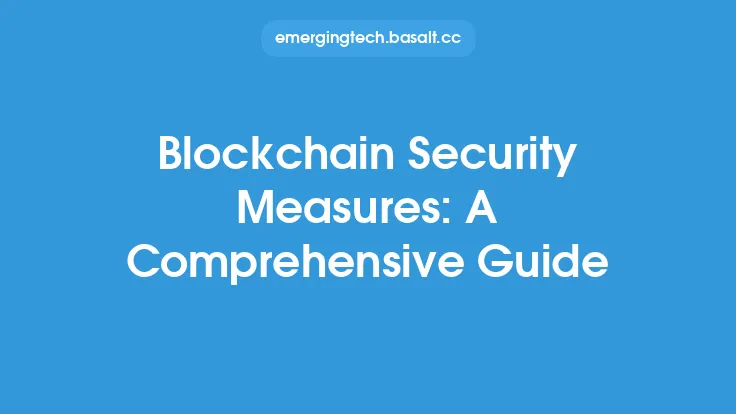The concept of blockchain scalability has been a pressing concern since the inception of blockchain technology. As the number of users and transactions on a blockchain network increases, the network's ability to process and validate transactions in a timely manner becomes a significant challenge. This is because most blockchain networks are designed to prioritize security and decentralization over scalability, resulting in limited transaction capacity and high latency. In order to overcome these limitations, various scaling solutions have been proposed and implemented, aiming to increase the throughput and efficiency of blockchain networks while maintaining their security and decentralization.
Introduction to Blockchain Scalability
Blockchain scalability refers to the ability of a blockchain network to handle an increasing number of users and transactions without compromising its performance. A scalable blockchain network should be able to process a large number of transactions per second, with low latency and high throughput. However, achieving scalability in blockchain networks is a complex task, as it requires balancing security, decentralization, and performance. The scalability of a blockchain network is typically measured by its transaction capacity, block size, and block time. Transaction capacity refers to the number of transactions that can be processed per second, while block size and block time determine how often new blocks are added to the blockchain and how many transactions can be included in each block.
Challenges in Scaling Blockchain Networks
Scaling blockchain networks is a challenging task due to several reasons. Firstly, the consensus algorithms used in most blockchain networks, such as proof-of-work (PoW) and proof-of-stake (PoS), are designed to prioritize security over scalability. These algorithms require significant computational power and energy consumption, making it difficult to increase the transaction capacity of the network. Secondly, the decentralized nature of blockchain networks makes it challenging to achieve scalability, as all nodes on the network must agree on the state of the blockchain. This requires a significant amount of communication and coordination between nodes, leading to increased latency and reduced throughput. Finally, the security of blockchain networks relies on the immutability of the blockchain, which makes it difficult to implement scaling solutions that compromise on security.
Types of Scaling Solutions
There are several types of scaling solutions that can be implemented to improve the scalability of blockchain networks. These solutions can be broadly categorized into two types: on-chain scaling solutions and off-chain scaling solutions. On-chain scaling solutions involve modifying the underlying architecture of the blockchain network to increase its transaction capacity and throughput. Examples of on-chain scaling solutions include increasing the block size, reducing the block time, and implementing more efficient consensus algorithms. Off-chain scaling solutions, on the other hand, involve processing transactions outside of the main blockchain network and then settling them on the blockchain. Examples of off-chain scaling solutions include state channels, payment channels, and sidechains.
On-Chain Scaling Solutions
On-chain scaling solutions involve modifying the underlying architecture of the blockchain network to increase its transaction capacity and throughput. One of the most common on-chain scaling solutions is to increase the block size, which allows more transactions to be included in each block. However, increasing the block size can compromise on security, as larger blocks are more difficult to propagate and verify. Another on-chain scaling solution is to reduce the block time, which allows new blocks to be added to the blockchain more frequently. However, reducing the block time can also compromise on security, as it reduces the time available for nodes to verify and propagate blocks. More efficient consensus algorithms, such as proof-of-capacity (PoC) and delegated proof-of-stake (DPoS), can also be implemented to improve the scalability of blockchain networks.
Off-Chain Scaling Solutions
Off-chain scaling solutions involve processing transactions outside of the main blockchain network and then settling them on the blockchain. One of the most common off-chain scaling solutions is state channels, which allow multiple transactions to be processed off-chain and then settled on the blockchain in a single transaction. Payment channels, such as the Lightning Network, also allow multiple transactions to be processed off-chain and then settled on the blockchain. Sidechains, which are separate blockchain networks that are pegged to the main blockchain network, can also be used to process transactions off-chain and then settle them on the blockchain.
Future of Blockchain Scalability
The future of blockchain scalability is promising, with several scaling solutions being developed and implemented. The use of more efficient consensus algorithms, such as proof-of-capacity (PoC) and delegated proof-of-stake (DPoS), is expected to improve the scalability of blockchain networks. The implementation of off-chain scaling solutions, such as state channels and payment channels, is also expected to increase the transaction capacity and throughput of blockchain networks. Additionally, the development of new blockchain architectures, such as sharding and parallel processing, is expected to further improve the scalability of blockchain networks. As the demand for blockchain technology continues to grow, the development of scalable blockchain networks will be crucial to supporting the increasing number of users and transactions.
Conclusion
In conclusion, scaling blockchain networks is a complex task that requires balancing security, decentralization, and performance. Various scaling solutions, including on-chain and off-chain solutions, have been proposed and implemented to improve the scalability of blockchain networks. The future of blockchain scalability is promising, with several scaling solutions being developed and implemented. As the demand for blockchain technology continues to grow, the development of scalable blockchain networks will be crucial to supporting the increasing number of users and transactions. By understanding the challenges and opportunities in scaling blockchain networks, developers and users can work together to create more efficient, secure, and scalable blockchain networks that can support a wide range of applications and use cases.





